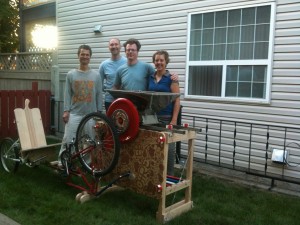Growing on the branches of city-owned apple trees in Edmonton is enough fruit to stuff over 10,000 pies, and the city is hoping residents are up to the task of baking them.

Provided
“If you know where they are, and you notice the fruit is up and ready to go, please help yourself,” says Catherine Falk, community greening coordinator with the City of Edmonton.
The problem is, in a city boasting over 320,000 trees on public land, most Edmontonians don’t know where the 145 apple trees, 98 pear trees, and 7,664 crabapple trees are located. Secondly, they don’t know they’re allowed to pick the produce. Two gaps, Falk says, the city is working to bridge.
APPLE AND PEAR TREES ON CITY PROPERTY
There are currently 145 apple trees and 98 pear trees on city property, all open for public picking.
Source: City of Edmonton
Mike Johnson, president of Operation Fruit Rescue Edmonton—a volunteer driven non-profit that harvests unused fruit on private property in Alberta’s capital—says on top of those gaps, people are “wary about fruits that don’t come from a supermarket or from a farm because there’s no quality assurance.”
Which, according to a study done in Massachusetts, is a worry unfounded. Scientists there found fruit grown in urban settings was largely pollutant-free, and actually more nutritionally beneficial than those from orchards.
CRABAPPLE TREES ON CITY PROPERTY
The crabapple trees are ornamental, and while they aren’t the tastiest fruit raw, they can be processed into delicious jellies, juices, and sauces.
Source: City of Edmonton

Source: Dalhousie University
Peter Duinker a professor of resource and environmental studies at Dalhousie University in Halifax, says on top of flood mitigation, air pollution control, and city beautification, fruit trees can contribute to food security, “mostly by making for a more aware citizenry.”
“From the standpoint of being able to deliver food to people who have a dickens of a time being able to afford it and pay for it, maybe we could make a bit of a difference,” he says.
Excerpt from Peter Duinker’s “Trees in Canadian Cities: Indispensable Life Form for Urban Sustainability”
Click annotation to see full document
OFRE is already contributing to that element of urban sustainability, by donating a quarter of the fruit it harvests to local charities, with another going to the volunteer picker, the homeowner, and finally, another to be processed. “There’s just unlimited possibilities to providing food security inside the city if we manage to harvest all the fruit and store it effectively,” Johnson says.
However, Duinker says fruit trees, and other forms of urban gardening, won’t make a big dent in food security unless there is a cultural shift in the way city-dwellers understand food production.
“I think most cities in Canada are just at crawling speeds right now in trying out some little pilot projects that legitimately excite people,” he says, “but not very many people.”
Currently, the city maintains the trees in the most basic sense, including watering and pruning, but has no program in place when it comes to collecting the produce. Johnson says it would make sense if this job was left up to private companies or individuals. “Instead of having an orchard outside the city, why can’t you actually have an urban orchard inside the city on the boulevard where the farmer can actually just go down the boulevard?” he asks.

Source: OFRE
Which is what OFRE did in 2014. The non-profit teamed up with the city to plant a micro-orchard on public property in the McCauley neighbourhood. The orchard is completely maintained by OFRE, and is designed to educate Edmontonians on the types of trees that can grow in the northern city—apples, pears, cherries, plums, and, when the province has a warm spring, apricots—as well as how to care for those trees.
Edmonton is attempting to excite its residents about urban food production, not only through its Root for Trees initiative, which is responsible for the annual planting of food forests, but its larger food and urban agriculture strategy, Fresh.
Excerpt from City of Edmonton’s Fresh Strategy
Click annotation to see full document
“If a community hall has a community garden, then they have fresh veggies all summer long,” Falk says. “Let’s say they have three apple trees and if they end up making apple pie and selling it at their community league fundraiser, well suddenly they’ve made money off something that’s a source from the City of Edmonton. So that’s really cool. That’s what we want to see happening.”

Source: City of Edmonton

